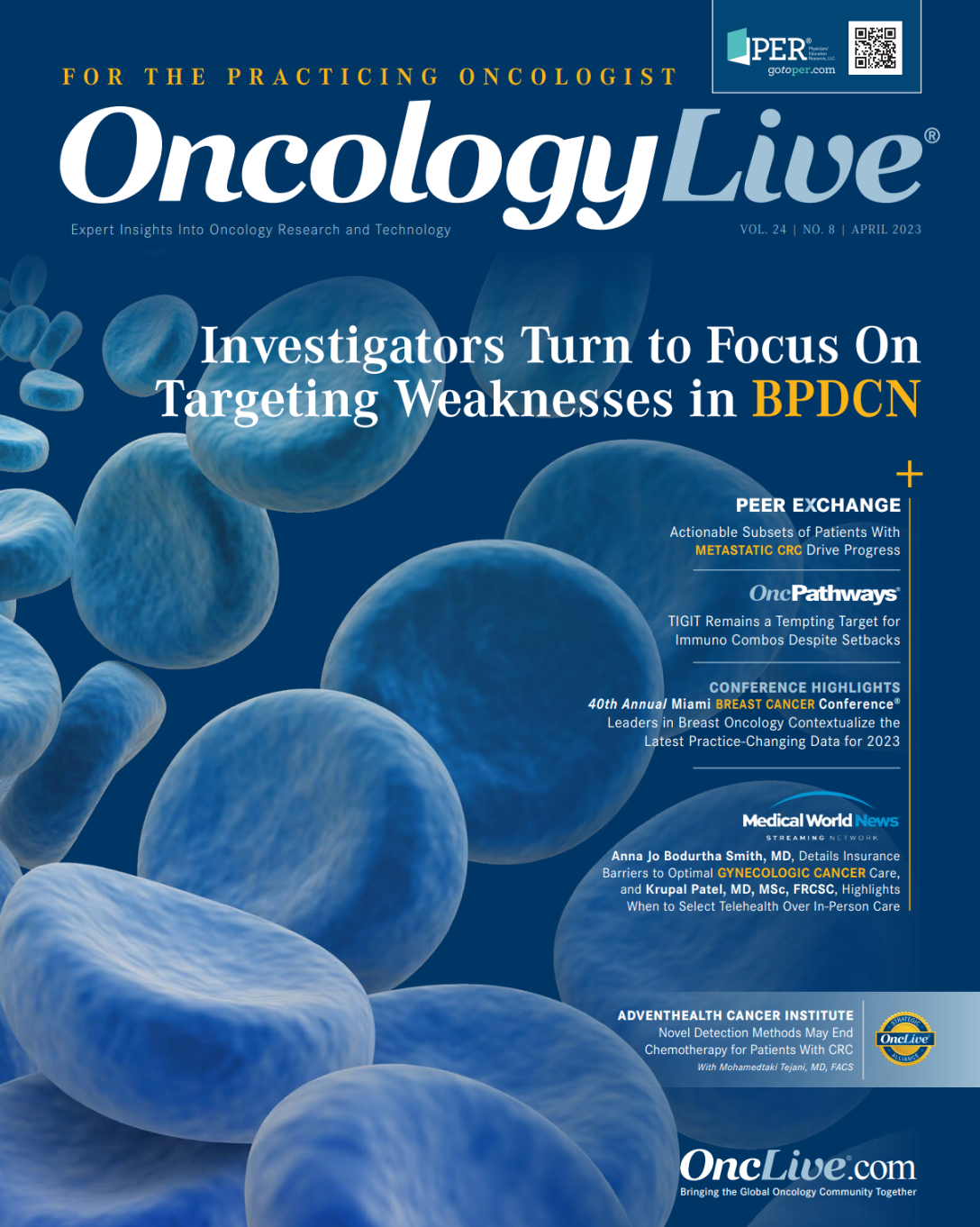Publication
Article
Oncology Live®
Oncology Financial Navigator Interventions Provide Benefits to Patients With Hematologic Cancers
Author(s):
To evaluate the prevalence of financial toxicity and observe the effect of Coverage and Cost-of-Care Links, a program providing financial navigation, investigators initiated a nonrandomized study.
Jean Edward, PhD, RN, CHPE

Patients with hematologic malignancies often experience high costs during treatment and require a caregiver. To evaluate the prevalence of financial toxicity and observe the effect of Coverage and Cost-of-Care Links (CC Links), a program providing financial navigation, investigators initiated a nonrandomized study (NCT05465577).
Financial navigation is “a comprehensive program where we’re screening for financial toxicity [and] helping the patient and the caregiver get connected with resources,” according to Jean Edward, PhD, RN, CHPE. “That sometimes involves helping them [to] find the right insurance plan, understand the insurance, understand the cost of care, and make calls on their behalf if they need to like a liaison at times and following up on those things.” Edward is an associate professor and assistant dean for diversity, equity, and inclusion at the University of Kentucky (UK) College of Nursing and a nurse scientist for UK HealthCare’s Markey Cancer Center, both in Lexington.
Results of the single-arm, feasibility CC Links study were recently published in JCO Oncology Practice. Investigators observed statistically significant decreases in the comprehensive score for financial toxicity (COST), defined as the psychological, material, and behavior aspects of financial hardship from cancer, using a paired t-test. The comparison of means for COST score for patients (n = 54) was 2.42 (P = .019) and 2.43 (P = .021) for caregivers (n = 32). The total financial toxicity difference was 1.53 (P = .13) for patients, and it was statistically significant for caregivers at 2.13 (P = .041). Further, material conditions score was also statistically significant for caregivers with a t-score of 2.25 (P = .031).
Participants in the study received an average financial benefit of $2500. The financial navigator secured a total of $124,600 for 48 participants with $24,000 toward travel, $16,000 toward urgent need, $9100 toward patient financial assistance, and $75,500 in copay assistance grants.
“As nurses we should understand that there are challenges and barriers to these costs and they are high,” Edward noted. “We need to be able to assess the social determinants of health. When you truly assess somebody’s social determinants of health, there are so many areas that come up that inform financial needs.”
In an interview with OncologyLive®, Edward highlighted implications of the study results and provided additional resources patients can use to help combat financial toxicity during cancer care.
“Nurses are big advocates for patients and when a patient shares, ‘I’m concerned about this; I’m not able to afford food for my family because I’m worried about paying for my chemotherapy or my treatment,’ then they need to be able to advocate for the patient so that they can bring up these concerns to the provider or the health care team.”
Edward explained that knowing what resources exist within the health system such as social workers, navigators, counselors, as well as financial assistance programs or patient grants are crucial. Cancer centers may have social workers who often aid with financial issues; however, they may be unable to assist with insurance or identifying barriers that exist with patient’s finances. Financial counselors may be an available resource at centers for those hurdles.
Of the 60 patients and 34 caregivers enrolled in the study, approximately one-third of patients (33.3%) and caregivers (31.3%) were living at or below the federal poverty level. The National Comprehensive Cancer Network’s Distress Thermometer and the Functional Assessment of Chronic Illness Therapy’s FACIT-COST measure were used to screen patients in the study, with a COST of less than 24 recorded for 90% of patients and 85.3% of caregivers. A distress thermometer score of more than 4 was recorded in 61.7% of patients and 54.5% of caregivers.
“I think we’re going to see a lot more individuals screening positive for financial toxicity in the future and that’s important,” Edward said. “We need to continue screening and understanding financial needs from a broader social determinants of health perspective…sometimes we would find that a patient would screen positive on the financial toxicity score, but on the distress thermometer they were fine, so they didn’t screen positive. That’s why it’s important that we use several tools, so we don’t lose anyone when we just go by a number.”
Of the 1179 patients screened in the study, 297 had a positive result for financial toxicity, with 219 meeting the study inclusion criteria. However, only 60 patients agreed to participate in CC Links and complete preintervention surveys, and 34 caregivers consented and completed the surveys. Although this indicates that only 27% of eligible patients enrolled in the study, 100% of eligible caregivers participated. Participants rated the intervention at 89% for acceptability and 88% for appropriateness.
The mean age for patients was 50.7 years and 46.6 years for caregivers. Most caregivers were a spouse or partner (50%). Other caregivers included adult child (25%), other relative (31.7%), or friend (11.7%). Most patients and caregivers were women (51.7% vs 52.9%) and White (91.7% vs 94.1%), and most had Medicare/Medicaid (64.4% vs 45.4%). Other insurance included TRICARE for 1 patient, and 5.1% of patients and 9.1% of caregivers had no insurance. Additionally, 30% of patients received a blood or bone marrow transplant (BMT) and 66.7% received chemotherapy. Furthermore, 36.7% of patients had lymphoma and 25% had leukemia.
One barrier for participation was contacting patients, and Edward noted that other compounding factors may have played a role, including general discomfort discussing finances. “To overcome that, we need to build trust with our patients and their caregivers before asking them these heavy financial questions and remind them we’re asking this information to help them,” Edward said. Additionally, some patients may wait until they receive bills or are struggling to pay them after being in treatment for a long period before calling a financial navigator with a worst-case scenario of experiencing bankruptcy or debt.
“We’ve noticed that when we talk about available resources, individuals will say, ‘I think somebody else could use that more than me,’ even if they’re struggling. That’s beautiful. It shows humanity, that [patients] do care and want someone else to benefit from this. We need to remind them that everyone’s eligible and anyone can join. We are assisting as many individuals as we can, so don’t feel bad about enrolling in this program,” Edward said.
Participants had an average of 3 in-person meetings (range, 0-21) and 5 telephone interactions (range, 1-23) with the financial navigator in the Division of Hematology and BMT at UK, a National Cancer Institute–designated cancer center where the study was conducted. Screening took place from April 2021 to January 2022 during inpatient and outpatient visits. The financial navigator aided patients and caregivers by screening participants, providing cost-of-care estimates, and coordinating financial assistance along with several other roles.
“Even though in this study we collected a lot of quantitative information and we’ve had positive outcomes, we also collected qualitative data and asked [patients and caregivers] what experiences they’ve had with the navigator,” Edward said. “Those words speak louder [and] show the tremendous impact that our financial navigation program had on these patients and their caregivers. Any data you can collect to show the impact that you’re having [are] going to speak volumes and help support work like this in the future.”
Edward also highlighted the adaption of CC Links for other populations. A financial and legal navigation intervention established in UK’s DanceBlue Pediatric Hematology & Oncology clinic in Lexington will be assisting patients affected by the impacts of childhood cancers.
“We recently received new funding from the Kentucky Pediatric Cancer Research Trust Fund [to] take CC Links and adapt it to be on a virtual telehealth platform,” Edward explained. “We partnered with Triage Cancer, the nonprofit [organization]. They provide free education on legal and financial issues and practical issues for survivors and caregivers. We’re going to use them to see what happens if we partner with a thirdparty entity. Could the ROI [return on investment] be affected? Could we have an easier workflow of screening and referring patients to the assistance that they need?”
Limitations to the CC Links study included a smaller sample size and the exclusion of nonEnglish-speaking participants. Additionally, the findings could not be generalized to other patients with cancer and caregivers, and the findings did not demonstrate feasibility.
Reference
Edward JS, McLouth LE, Rayens MK, Eisele LP, Davis TS, Hildebrandt G. Coverage and Cost-of-Care Links: addressing financial toxicity among patients with hematologic cancer and their caregivers. JCO Oncol Pract. Published online March 8, 2023. doi:10.1200/OP.22.00665

















Latest Conference Coverage

Targeted Therapies for NSCLC With Nonclassical EGFR Mutations Grow Increasingly Personalized

Next-Generation Sequencing Data Inform IO Treatment Sequencing in NSCLC

Neoadjuvant Botensilimab Plus Balstilimab Yields High MPR Rates in CRC

Comparable Survival Outcomes Observed With Atezolizumab/Bevacizumab vs Tremelimumab/Durvalumab in First-Line HCC
Neoadjuvant Atezolizumab/Trastuzumab/Pertuzumab Is Effective and Safe in HER2+ Early Breast Cancer
Alisertib Plus Ibrutinib and Rituximab Shows Preclinical Efficacy in MCL Models
Venetoclax Plus Obinutuzumab Improves MRD Clearance in Previously Untreated CLL
Cancer Vaccine Shows Promise for Patients With Stage III and IV Kidney Cancer
2 Commerce Drive
Cranbury, NJ 08512





